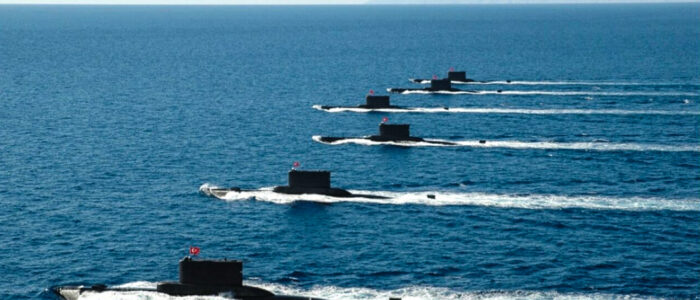The anti-access/area denial (A2/AD) strategy in naval warfare, designed to deny enemy access and ability to conduct operations in an area, heavily relies on a range of anti-ship and anti-submarine capabilities along with potent air-air defence capabilities. The capabilities themselves depend on a range of submarines, surface ships, and attack aircraft. The safe zone created due to A2/AD capabilities depends upon the operational ranges of attack drones, ballistic, and cruise missiles. However, building and maintaining a large number of submarines and warships is a costly affair. The Shallow Water Attack (SWAT) submarines present a cost-effective and flexible solution for achieving and diversifying A2/AD capabilities.
The SWATs are larger than the mini-submarines used by special operation forces (SOFs) and smaller than the traditional submarines deployed in deeper waters. However, they can perform the functions of both, including intelligence gathering, SOFs deployment, mine laying, anti-ship, and anti-submarine warfare. The key is their smaller size and lesser costs than the traditional submarines. They cost a fraction of the price of the traditional conventional submarine.
Besides, SWATs are stealthier, more survivable than surface ships, and extremely useful in shallow waters. Because they weigh less than traditional submarines, their acoustic and magnetic signatures are also smaller, adding to their safety even in shallow waters. In terms of warfare utility, they can perform reconnaissance and intelligence gathering along with mine laying, firing torpedoes, and firing anti-ship and land-attack cruise missiles, establishing them as valuable platforms.
The Case of SWAT for Pakistan Navy
Pakistan Navy is undergoing some serious efforts to enhance its A2/AD capabilities. Under these efforts, Pakistan plans to increase the number of both surface and sub-surface ships along with qualitative additions to them. According to Ex-Naval Chief Adm. Zafar Mahmood Abbasi, the navy plans to have more than 50 warships, including 20 major surface combatants. Besides these, the navy will get eight air-independent propulsion (AIP)-equipped submarines from China. These additions are going to provide the navy with considerable parity against the Indian Navy.
Using SWAT for anti-ship and reconnaissance roles will decrease the navy’s dependence on larger conventional submarines to deploy in deeper waters and for more strategic purposes.
However, the introduction of SWATs in the fleet can complement these planned ships. A diverse range of ships and submarines will add to the operational flexibility of the navy as well as provide it with a wider range of options against the ever-increasing challenges in the wider Indian Ocean. With the diversified underwater capabilities of the navy, Indian aircraft carrier, major surface ships will consider the presence of SWATs while attempting blockade of Pakistan sea lines of communications or its major ports. Multiple factors have increased the significance of the country’s seaward defence, such as maritime economy, operationalisation of Gwadar Port, and increasing threats from hostile navies in the sea.
Using SWAT for anti-ship and reconnaissance roles will decrease the navy’s dependence on larger conventional submarines to deploy in deeper waters and for more strategic purposes. Pakistan has assigned its moderate second-strike capabilities to the Agosta and possibly to the upcoming submarines from China. Thus, they become strategic platforms for the navy. Therefore, SWATs fitted with the necessary capabilities can be deployed in shallow waters. Moreover, SWATs can be a viable alternative for Fast Attack Crafts (FACs), such as the Azmat class of the Pakistan Navy, which are almost identical in terms of their sizes, capabilities, and operational roles. Such submarines operating in shallow waters would be more lethal and survivable than the surface ships, which are easier to detect and target.
Pakistan is already operating the X-Crafts (Cosmos MG110) for its SOFs. However, these are mini-submarines suitable only for SOFs and mine laying with no significant utility in anti-ship or anti-surface warfare. They were built locally between 1993 and 1996 with the assistance from Italian firm Cos.Mo.S. They are operated by the Navy’s Special Service Group, known as SSG (N). It is reportedly developing another X-Craft to be used for the same purposes as the already operational boats.
STM-500
The most recent example of SWAT is the STM-500 by the Turkish firm STM. It is comparable in weight with the Azmat Class Fast Attack Craft (FAC) ships of the Pakistan Navy. The STM-500 submarine has a submerged displacement of 540 tons, a length of 42 meters, and a maximum beam of 8.5 meters. With the capacity to travel at a maximum speed of 18 knots, it can dive up to 250 meters and has a cruise speed of 5 knots. The submarines will have a range of 3,500 nautical miles running on their diesel engines and 75 nautical miles when fueled by batteries. Moreover, STM-500 is also said to be fitted with an air-independent propulsion (AIP) system, which, when combined with diesel propulsion, can extend the boats’ range to 4,000 nautical miles, which makes them quite formidable.
These are also equipped with other essential features of submarines, such as various types of sonars, an optronic periscope and an electronic warfare support measures (ESM) antenna. With a crew of more than 18 members and a six-member special forces team, STM-500 can stay submerged for 30 days. Its armament is said to be around four torpedo tubes, with the ability to fire eight heavyweight torpedoes or cruise missiles. The submarine is planned to enter the construction phase in 2022 and will take approximately 48 months to complete. The Turkish Navy plans to deploy these submarines in its littoral waters as power multipliers.
Pakistan-Turkey has already collaborated for the modernisation of the Pakistan Navy’s Agosta-90B submarines, the building of Milgem Class Corvette, and the construction of Jinnah Class frigates. Cooperation for SWATs could be another possible step between the two countries.
